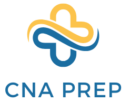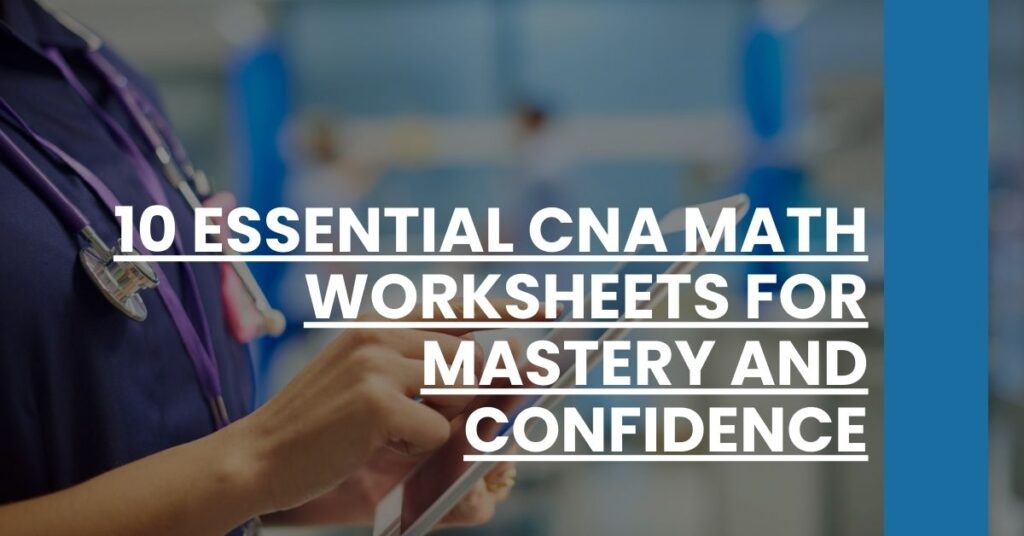cna math worksheets Ever catch yourself scratching your head over medication dosages or unit conversions?
CNA math worksheets are your secret weapon.
Within this article, you’ll discover targeted exercises that not only sharpen your calculation precision but also uplift your confidence in patient care.
No fluff, just the essentials waiting to upgrade your skills.
- 1. Vital Calculations for Standard Care
- 2. Worksheets on Interpreting Medical Measurements
- 3. Mastering Dosage and Medication Administration
- 4. Understanding Patient Nutrition and Intake Calculations
- 5. Exercises on IV Drip Rate and Volume Calculations
- 6. Monitoring Vital Signs Through Mathematical Lenses
- 7. Effective Charting and Recording Practice
- 8. Time Management and Scheduling Scenarios
- 9. Calculation of Body Mass Index (BMI) for Patient Assessment
- 10. Interpreting Laboratory Results with Numerical Proficiency
- Leveraging Technology in CNA Math Mastery
- Conclusion: Building a Solid Mathematical Foundation in Nursing
1. Vital Calculations for Standard Care
As a Certified Nursing Assistant (CNA), you are the backbone of patient care. Performing essential healthcare tasks with precision is part of your day-to-day responsibilities. To ensure that these tasks are carried out accurately, having a solid foundation in basic math is crucial. This is where CNA math worksheets come into play.
Imagine you’re tasked with converting a patient’s weight from pounds to kilograms or calculating the right dosage of medication. Sounds daunting? Not when you have the right practice tools! Consider these tailored worksheets your secret weapon:
- Unit Conversion Practice: Sharpen your skills in converting units of measurement—a fundamental task in a CNA’s role. To get started, try exercises from resources like the comprehensive math practice worksheet for converting ounces to milliliters or pounds to kilograms.
- Medication Dosage Calculations: Ensure patients receive the correct amount of medicine with dosage calculation worksheets. These are indispensable tools for avoiding medication errors and ensuring patient safety.
By incorporating these worksheets into your study routine, you’ll enhance not only your competency but also your confidence in carrying out standard care calculations. Working through these practice scenarios prepares you to tackle any numerical challenge with ease.
2. Worksheets on Interpreting Medical Measurements
Understanding medical measurements is a critical component of your role. The ability to interpret these readings correctly can impact patient assessments and subsequent care plans. But fear not, as specific worksheets are designed to build this very skill. Dive into scenarios that simulate:
- Blood Pressure Readings: Learn the nuances of systolic and diastolic figures and their implications for patient health.
- Temperature Conversion: Master the conversion between Fahrenheit and Celsius, ensuring you’re always on point when assessing a patient’s fever.
To solidify your understanding of medical measurements, the website UnitsLab.com is a helpful reference, offering metric conversion tables and an online calculator.
3. Mastering Dosage and Medication Administration
Next, let’s navigate the complexities of dosage and medication administration. Here, precision is not just valued; it’s expected. With specialized worksheets, you’ll practice calculations and scenarios to help prevent medication errors—a crucial aspect of patient care.
Your worksheet agenda should focus on techniques such as:
- Formula Method: Using simple formulas to calculate the correct dosage.
- Proportion Method: Establishing ratios and proportions to determine how much medication to administer.
A practical aspect of mastering this area is available through the medication dosage calculation practice sheets. Here, you can translate theoretical knowledge into real-world expertise.
4. Understanding Patient Nutrition and Intake Calculations
Patient nutrition is another facet of CNA work that demands accuracy. Whether you are managing dietary restrictions or calculating calorie needs, the math involved is crucial for ensuring optimal patient health. Employ worksheets that cover:
- Caloric Needs Calculation: Estimate the number of calories a patient requires based on their age, sex, and level of activity.
- Fluid Intake Tracking: Monitor and calculate daily fluid intake, especially vital for patients with specific health conditions.
For insights into the importance of patient nutrition and feeding, the Nutrition Basics and Patient Feeding Ceu document provides valuable context for your worksheet exercises.
5. Exercises on IV Drip Rate and Volume Calculations
IV administration is a delicate task that requires accuracy. Understanding how to calculate drip rates and volumes accurately is a non-negotiable skill. Through targeted worksheets, you can practice:
- Drop Factor Calculation: Determine the correct IV drip rate based on the medication’s drop factor.
- Elapsed Time Calculation: Calculate the amount of time an IV should run to administer a specific volume.
For hands-on practice, the IV flow rate practice quiz challenges you with real-world problems, strengthening your ability to manage IV drips confidently.
6. Monitoring Vital Signs Through Mathematical Lenses
Lastly, no CNA can afford to underestimate the importance of vital signs. Your numerical proficiency here is directly linked to the well-being of those under your care. Worksheets in this domain help you understand the correlations between numbers and health, teaching you to analyze:
- Heart Rate Patterns: Identify arrhythmias or other irregularities that may signal critical conditions.
- Respiration Rates: Assess whether a patient is breathing normally or if intervention is required.
To gain a deeper understanding of these crucial measurements, engaging activities can be found in the lesson plan on vital signs and monitoring. It’s a pivotal resource to complement your worksheet practice.
By mastering the mathematical aspects of these vital signs, you’ll be equipped with a sharper eye for detail and a readiness to act when seconds count.
7. Effective Charting and Recording Practice
In your role as a CNA, charting and recording patient information is not just a routine—it’s a cornerstone of quality healthcare. It ensures that all team members are up-to-date on a patient’s condition and that care is continuous and consistent. And at the heart of effective charting? Precise and timely math skills.
Here’s how CNA math worksheets can bolster your recording prowess:
- Medication Tracking: Routinely update medication sheets, requiring an exact account of dosages and times administered.
- Intake and Output Records: Keep a meticulous record of patient fluid intake and output—an area where precision can speak volumes about a patient’s condition.
- Weight and Height Measurements: Accurately charting growth metrics can aid in assessing overall health and detecting potential issues.
For practice scenarios reflective of the real world, consider resources that offer an in-depth look at CNA duties and documentation. These will provide a systematic approach to upskill your charting qualifications and reinforce the importance of accuracy.
8. Time Management and Scheduling Scenarios
Balancing a myriad of tasks efficiently is a universal challenge in nursing. As a CNA, your ability to manage time effectively is paramount for the wellbeing of your patients. That’s where your number-crunching ability intersects with your organizational skills. Scheduling scenarios on worksheets will help you:
- Prioritize Patient Needs: Recognize which patient needs are urgent and learn to allocate your time accordingly.
- Manage Shift Duties: Optimize duty rosters, making sure that all patients receive timely care, even when the unit is bustling.
- Develop Contingency Plans: Be prepared for unexpected situations by learning to adjust your schedule on the fly.
To elevate your expertise, immerse yourself in the art of nursing time management, where scenarios challenge you to refine these critical skills.
9. Calculation of Body Mass Index (BMI) for Patient Assessment
Assessing a patient’s Body Mass Index can offer valuable insights into their general health status. As a CNA, you will find that understanding and calculating BMI is yet another skill to hone. Here are types of exercises to expect:
- Determine BMI using standard formulas, factoring in height and weight.
- Interpret the results to understand a patient’s potential health risks related to their weight category.
Although it does not provide practice worksheets, the healthy lifestyle recommendations by WHO includes a BMI calculation breakdown—perfect for building your BMI acumen.
10. Interpreting Laboratory Results with Numerical Proficiency
Interpreting lab results is often seen as the domain of doctors and nurses, but as a CNA, you too play a role in this analytical dance. Math competence gives you an edge in understanding patterns and changes in patient data. Sharpen your skills using worksheets that delve into:
- Lab Value Comprehension: Grasp the significance of common lab values and their implications for patient care.
- Trend Analysis: Learn to recognize significant changes in lab results over time, possibly indicating a shift in the patient’s condition.
While specific CNA-related resources on interpreting laboratory results might be scarce, broadening your mathematical foundation invariably enhances your ability to tackle such data with confidence.
Leveraging Technology in CNA Math Mastery
In an era where digital tools have revolutionized learning, your journey to mastering CNA mathematics is no exception. Technology extends its hand, offering platforms and mobile apps that transform traditional worksheets into engaging, interactive experiences. Let’s consider just a few:
- Apps for Calculation Practice: These offer a portable means to sharpen your calculation skills on-the-go.
- Virtual Simulations: Immerse yourself in realistic patient scenarios where your math and time management abilities can be tested in a safe environment.
- Online Quizzes and Flashcards: Utilize these for quick, targeted practice sessions that reinforce memory and recall.
By thoughtfully incorporating technology into your study regimen, every aspect of your CNA math worksheets becomes an opportunity for growth, accessible anytime, anywhere.
Conclusion: Building a Solid Mathematical Foundation in Nursing
The importance of a strong mathematical foundation in your CNA practice cannot be overstated. It’s integrally woven into every patient interaction, every chart update, and every decision you make. The beauty of CNA math worksheets is that they offer a structured, focused approach to this fundamental skill set.
Elevate your practice by embracing these essential math exercises. The proficiency you gain will reflect in the quality of your care, and the confidence it instills will beam across the halls of your workplace. So go ahead, set aside some time, and start crunching those numbers—your future self (and your patients) will thank you.

